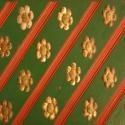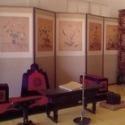Wallpaper - Types of Printing
Wallpaper - Types of Printing
The most widely used print processes are surface, flexographic or flexo, gravure and screen. It is important to recognize that each process is capable of yielding attractive, stylized and salable products. Each process enables the manufacturer to produce a specific characteristic look.
The most common types of printing are:
Surface Printing
Surface printing is most often employed to reproduce a stencil-like effect for traditional florals, juvenile and country motifs. This is accomplished through the use of light weight urethane print cylinders. The print design actually coincides with raised areas on the roller. This raised portion is obtained by removing or cutting away metal to leave the desired design elevated above the rest of the cylinder (like an ink stamp). Printing is accomplished by first applying ink onto the raised areas. The inked roller is then pressed against the material to be printed causing the ink color to be transferred from the surface of the raised design onto a moving web of wallcovering. One roller is required for each color.
Flexographic Printing
 Flexo, or flexographic printing, is similar to surface printing except the print cylinders employed are made of flexible materials, usually rubber. The flexo process is used to yield a range of country, colonial, floral and mini-print designs. This process offers the manufacturer a technique for achieving more delicate design than is possible with metal surface rollers. Some tonal effects are possible.
Flexo, or flexographic printing, is similar to surface printing except the print cylinders employed are made of flexible materials, usually rubber. The flexo process is used to yield a range of country, colonial, floral and mini-print designs. This process offers the manufacturer a technique for achieving more delicate design than is possible with metal surface rollers. Some tonal effects are possible.
Screen Printing
Screen printing is accomplished in two ways, using either flat or rotary screens. Hand screens, commonly called silk screen printing, is carried out by using flat mesh screens held within a frame. The design image area is reproduced onto the mesh screen. The screen or mesh area is covered with a resist, such as wax, which plugs or blocks all of the screen openings, except in the area of the design image. Ink is then applied to the flat screen. A rubber squeegee is then used to push the ink along the screen surface. In this way ink is forced through the openings in the design area onto the wallcovering. Ink cannot be applied in the areas previously blocked by the resist. One screen is needed for each color. This process is most often used for specialty and customized products.
Rotary Screen
 Rotary screen is a new high speed production technique to replace hand screen printing. In this system, a rotary or round screen mesh cylinder is employed. Ink is fed into the inside core of the cylinder and an internal squeegee blade is used to press or apply ink through the image area of the screen. The ink will not flow through the rotary screen where a resist has been used to block or seal the mesh where printing is to take place. Rotary screen printing is used for designs where a bright, solid color laydown is required. These includes graphics, contemporary and traditional floral paisley, geometrics, etc. It is also used for expanded vinyl prints. A specially formulated ink is used to print the design. It then goes through a heat tunnel, which activates a blowing agent causing the ink to expand, creating a puffed, or three-dimensional look.
Rotary screen is a new high speed production technique to replace hand screen printing. In this system, a rotary or round screen mesh cylinder is employed. Ink is fed into the inside core of the cylinder and an internal squeegee blade is used to press or apply ink through the image area of the screen. The ink will not flow through the rotary screen where a resist has been used to block or seal the mesh where printing is to take place. Rotary screen printing is used for designs where a bright, solid color laydown is required. These includes graphics, contemporary and traditional floral paisley, geometrics, etc. It is also used for expanded vinyl prints. A specially formulated ink is used to print the design. It then goes through a heat tunnel, which activates a blowing agent causing the ink to expand, creating a puffed, or three-dimensional look.
Gravure Printing
 Gravure printing, also referred to as Intaglio, is the one process which offers the designer the opportunity of achieving a complete, continuous color deposit ranging from 100 percent full tone down to almost a 5 percent tone. Gravure is the costliest manufacturing process since the cylinder used requires copper plating and a special photochemical engraving or etching process.
Gravure printing, also referred to as Intaglio, is the one process which offers the designer the opportunity of achieving a complete, continuous color deposit ranging from 100 percent full tone down to almost a 5 percent tone. Gravure is the costliest manufacturing process since the cylinder used requires copper plating and a special photochemical engraving or etching process.
Printing is accomplished via tiny cells or ink reservoirs which are engraved into the surface of the print cylinder. In contrast to surface printing, with gravure the ink is held within tiny cells engraved into or below the cylinder surface. The deeper the cell, the darker the tone printed. By varying the size and placement of each cell, varying amounts of ink can be deposited onto the wallcovering by pressing the inked cylinder against the web. Pressure causes the ink to flow from within each cell onto the wallcovering. This process is the most versatile since it can duplicate a complete range of visual effects, and is able to give an almost photographic effect.
Content Provided by the Wallcoverings Association (WA).
Wallpaper - Types of Printing
Comments
Post a Comment